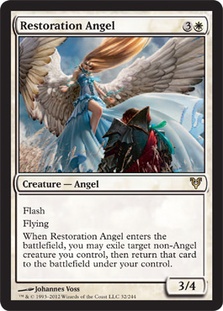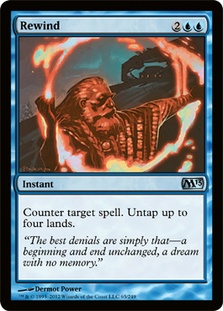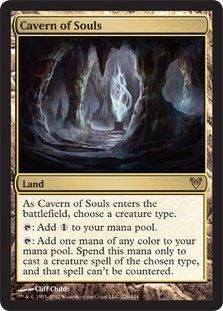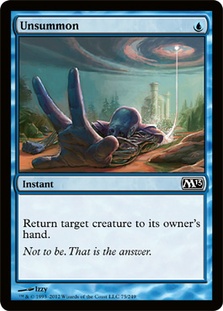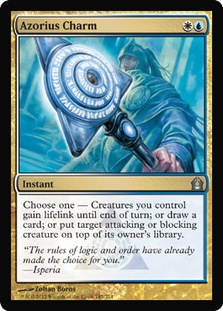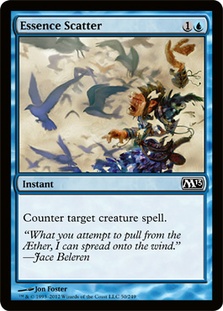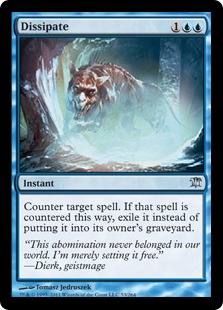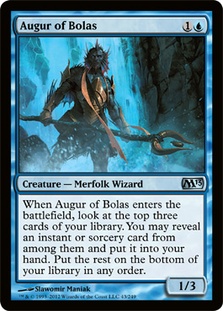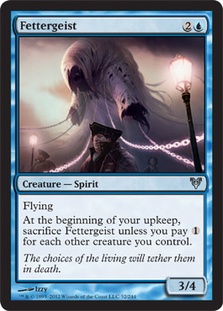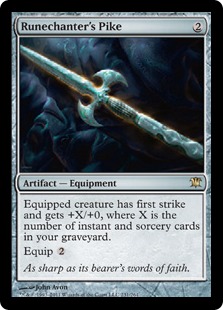Standard is shaping up to have diverse, healthy metagame full of plenty viable decks. While Thragtusk is still looming and still dominates underprepared opponents, I think that people are finally starting to figure out how to fight this menace. Over the last few weeks, Thragtusk decks have continued put up (un)surprisingly strong numbers, but there’s hope. While I was durdling with Geist of Saint Traft in a U/W/R Tempo shell, a Mr. Adam Prosak took a completely different approach to the same problem.
Apparently, blue decks can handle Thragtusk without needing to be overly aggressive. In fact, you can be inherently defensive against any non-Thragtusk deck and still be able to “pull the trigger” when it’s necessary. Much like Faeries in the days of old, control decks are no longer able to completely rely on “draw-go” game plan. They have to have a way to close out games quickly. There are so many powerful cards in Standard that even a single one resolving could put you outrageously far behind. Even with cards like Jace, Architect of Thought and Tamiyo, the Moon Sage at your disposal, there are a plethora of cards that can overcome you without much effort.
The problem, and also the solution, is Restoration Angel.
With the original U/W shell, I found myself wanting. I’d occasionally run out of gas thanks to the attrition-heavy environment and desperately needed to close the game when I began to fall behind. I played with the deck a fairly reasonable amount, and over time I figured out some positive changes that I’ve grown to love!
As of now, here’s my current decklist for U/W Flash:
Creatures (12)
Lands (24)
Spells (24)
- 2 Dissipate
- 4 Unsummon
- 1 Rewind
- 2 Syncopate
- 2 Think Twice
- 3 Essence Scatter
- 2 Runechanter's Pike
- 4 Thought Scour
- 4 Azorius Charm
Sideboard

The deck plays very similarly to Faeries with most of your cards being instants or having flash, which gives you the added benefit of never having to tap out on your own turn. This ensures that your opponents have to play around everything and will constantly fall into your traps. With so many traps for them to fall into…
Your deck is packed to the brim with reactive and situational spells, but the trick is building the board state so that your opponents have to fall into one or the other or just do nothing at all (which is also acceptable). With cards like Rewind and Restoration Angel in your deck, it’s virtually impossible for your opponent to make the correct attacks since Restoration Angel is bigger than most creatures in Standard!
While I know that Thragtusk is dominant, this deck preys on decks that play it because they are so horrifically slow. While they try to play mana acceleration in order to combat this drawback, four Farseeks isn’t nearly enough to make up for a bunch of four-to-seven-drops. Jund and Bant have the same problem since they can’t even remotely put pressure on your until they hit four or five mana. While they play out similarly, they do have different methods of attack. Luckily for you, Jund is full of sorcery speed spells, making their turns rather academic. If they have something to do, they normally do it. They cast their creature, hope it resolves, and move on to the next turn. If they see a creature, they kill it. Rinse, wash, repeat.
Bant is a little different. Bant has counterspells at its disposal, and four of the creatures it usually plays have flash. Restoration Angel is as good against you as yours are against them, which is very good, but you have plenty of ways to deal with it. While Unsummon is your best “answer,” you need to have a follow up counterspell to keep it out of your way. While you’ll occasionally have access to Runechanter’s Pike and invalidate their blocking capabilities, this isn’t always the case.
You have to be careful against other Restoration Angel decks because they will often use their Restoration Angels as bait so that they can resolve them more damaging spells, such as Thragtusk or what have you. Since their Restoration Angels don’t act as much of a threat on your own, you can just choose to ignore them until you are no longer vulnerable to their other annoying creatures.
Your early turns against a lot of the slower decks should focus on drawing cards and sculpting your hand to lock them out of the late game. Since they give you so much time to set up and few of their cards actually matter before the fourth turn, you have a lot of time to cast things like Augur of Bolas or use Snapcaster Mage to flashback Thought Scour. When they opt to pass the turn to play around Syncopate or the like, that just gives you a free window to resolve Restoration Angel, which can be combined with Snapcaster Mage or Augur of Bolas for value. My favorite turns with the deck are the ones where my opponent doesn’t cast anything and I’m free to use my mana as I see fit, casting whatever I have at my disposal.
With so many “value” creatures (or cards that gain some advantage just by casting them), you rarely run out of things to do with your mana. Augur of Bolas and Snapcaster Mage both apply a reasonable amount of pressure to the slower decks while keeping your hand full of the necessary defensive measures. Augur of Bolas also plays surprisingly well with Restoration Angel, helping you dig for whatever answers you need over the following turns.
While Augur of Bolas isn’t normally a card I’d consider playing in a tempo-based deck, this isn’t really one of those decks. We don’t have Delver of Secrets or Geist of Saint Traft, so we really aren’t that aggressive. We can be aggressive when the time calls for it, but the early turns of the game are all about setting up and taking control. If you don’t have control of the game, it’s rare that you’ll be able to become the aggressor. Racing a deck like Mono-Red Aggro or Zombies isn’t easy to do, and you need to make sure you can’t lose before you start turning creatures sideways.
With Runechanter’s Pike and Azorius Charm, sometimes this is the complete opposite. I find myself on occasion using the “lifelink” ability on Azorius Charm when combined with Runechanter’s Pike to gain huge swings of life. When this happens, you’re basically telling your opponent that they need to kill you on the next turn or they’re likely dead. With so many cards like Unsummon and Azorius Charm, combined with the defensive nature of Augur of Bolas, this can be a difficult situation for aggressive decks to surmount.
I don’t want to give you guys the wrong idea. This deck lies somewhere in the gray area between tempo and control. We aren’t using miracles. We aren’t using planeswalkers. We don’t really like to tap out, honestly. We just want to force our opponents to cast their spells into our counterspells and take advantage of the mana disparity gained by casting something like Essence Scatter on a Thragtusk. The things you do during the small windows are ultimately more important than the act itself. If you aren’t using that excess mana to your advantage, then you aren’t really gaining anything by countering their spells.
This is where a nifty new addition comes in:
Rewind is the best of both worlds, but you have to keep in mind that it isn’t cheap to cast. Of course, with the rest of your counters, it’s likely you’ll reach four mana and be able to cast it. However, if it’s your only counterspells in the opening turns of the game, you’re leaving yourself vulnerable to a variety of threats. This is my main reason for only playing a singleton in the maindeck. While having access to multiple Rewinds is awesome in certain matchups, I don’t think you can afford to draw too many against a deck like Zombies or Mono-Red Aggro.
In the matchups where it’s good, Rewind allows you to do some dirty things. I’ve done everything from activating a Moorland Haunt twice to gaining an extra blue mana to flashback a Think Twice when I drew too many Plains. Rewind is awesome with Restoration Angel since you can cast both in the same turn. Combine Rewind with Snapcaster Mage and things start to get disgusting.
While Rewind isn’t always the counterspell you want, it does allow for some flexibility in the late game, where you don’t always want to tap out to counter certain spells that aren’t backbreaking but can be troublesome. A great example of this is Centaur Healer, which can be an annoyance thanks to its pressure and life gain, but you don’t really want to tap out to counter it. Countering something like it leaves you vulnerable for the rest of the turn, which is unacceptable in a lot of situations.
Of all the counters, I think Essence Scatter is the most important. Essence Scatter allows you to use your mana the most efficiently over the course of the game while still countering almost everything in the format worth countering! Sure, there are planeswalkers and Keyrunes which can pose a threat, but pretty much every deck plays some creature that’s a must-counter, from Thragtusk to Geist of Saint Traft to Sublime Archangel. In the turns that matter most, you can cast Augur of Bolas, Restoration Angel, or just Snapcaster Mage and still use Essence Scatter to snag your opponent’s play. It’s also much easier to use Snapcaster Mage with Essence Scatter than Dissipate or Syncopate since it’s less mana intensive.
While I think the deck is awesome, there are some very problematic cards that you can face.
For one, Cavern of Souls will ruin your day. While you’ll be able to beat some of those decks, a Cavern of Souls protecting Thragtusk will be incredibly difficult to race. Hopefully, by that point you’ve cast quite a few Thought Scours and have a Runechanter’s Pike in play. My win percentage against decks without Cavern of Souls is around 90%, whereas I’ve only won two matches against decks with it. This particular build of U/W preys on the fact that Cavern of Souls isn’t widely played. The deck uses its counterspells as best it can, but there’s just nothing you can do when your opponent casts a creature like Thragtusk using Cavern of Souls. You can’t counter it. You can’t kill it. And you can’t even really race it thanks to the huge swing in life that it brings.
Cavern of Souls also does something crazy to your mindset when you’re playing with this deck. You can’t afford to sit back on counters anymore and instead have to race their plays. This means that even if they cast spells without using Cavern, you likely won’t have mana left open to counter things because you have to focus on racing whatever they have in play. Of course, this isn’t a certainty. After all, a Zombies deck using Cavern of Souls still has a tough time dealing with Azorius Charm, Augur of Bolas, and Restoration Angel. Against these decks, you can sideboard into a strategy that relies less on counterspells and focuses more on tempo. Cards like Fettergeist can easily switch roles between blocker and attacker, giving you an edge in the early game when devising your plan to victory.
Speaking of Fettergeist, this is the first deck I’ve ever played where I really feel like Fettergeist is amazing in it. This might be due to the fact that so few removal spells in the format actually kill it or because I haven’t played a deck like this without Geist of Saint Traft. I’ve tried out Geist of Saint Traft in various versions, but the lack of aggressive removal is pretty awful and I don’t want to cast things like Feeling of Dread. Without Searing Spear and/or Pillar of Flame to remove their blockers from play, Geist of Saint Traft is much worse. I also hate tapping out in the early parts of the game to play a threat, even if that threat is Geist of Saint Traft. There’s so much that can go wrong if you’re on the play and even more when you’re on the draw, and I don’t want to be casting Geist of Saint Traft on any turn but turn 3 if I can help it.Â
Let’s go over some of the cards in the deck and their roles at various points during the game.
These cards are primarily for catching certain creatures that fall through the cracks in your counters. Azorius Charm has a few other modes, most notably the “draw a card” one, and will be useful in various matchups for this reason alone. Giving your Snapcaster Mage something to do in the early turns while providing you with a body to start attacking can be helpful. Since Azorius Charm isn’t that useful other than drawing a card in some matchups, it’s pretty easy to side out. However, I do want it against every aggro deck in the format, and I don’t think I’d ever cut it from the maindeck. Four is the number I want and the number it will stay.
Unsummon, while being an incredibly efficient defensive maneuver, can help protect your creatures from various removal spells. Since Abrupt Decay and Supreme Verdict can’t be countered, it can be beneficial to use Unsummon to protect your threats. Since the majority of your creatures have flash, you can even recast them at the end of turn to continue the beats. Unsummon also pairs incredibly well with Snapcaster Mage to help rebuy counterspells when games go pretty long against various control and midrange decks. While Unsummon isn’t quite as powerful as Vapor Snag, I actually think it’s better in this deck than Vapor Snag would be since we aren’t as aggressive as traditional Delver decks and tend to target our own creatures about as much as we target theirs.
These along with Rewind are the heart of the deck and keep you from losing to the format’s most powerful threats. While Thragtusk remains enemy #1, the ability to counter basically any threat your opponent casts is pretty absurd. Since there’s been a recent uptick in the number of planeswalkers used in various strategies, counters like Dissipate and Syncopate can be invaluable. I always find it strange to think that Essence Scatter can be a dead card, but I know it is when my opponent leads with Drowned Catacombs or Isolated Chapel. These control decks can be difficult to overcome in the first game since you have a few dead cards, but after sideboarding they aren’t much of an issue. Their removal is easily handled by Unsummon and your other counters, and they’re forced to tap out turn after turn in order to deal with your various threats.
While Lingering Souls can be problematic if it resolves, we can usually power through it thanks to Moorland Haunt and Runechanter’s Pike, but it isn’t easy. Lingering Souls is one of the best cards that any opponent can have against our deck because it can buy them a lot of time. When we want to be the aggressive deck, Lingering Souls can singlehandedly alter that strategy. It is essential that we use Syncopate or Dissipate to counter Lingering Souls since they won’t be able to flash it back.
The counterspells are awesome and are definitely what I want to be doing in this format, but a single Cavern of Souls can invalidate half your answers. This is problematic, and I don’t recommend this strategy once people start playing Cavern of Souls in every deck again.
These creatures and Restoration Angel are better than pretty much anything else at your disposal, including Geist of Saint Traft. It took me quite a while to grasp the fact that Geist of Saint Traft just isn’t viable in this strategy. Since it can’t ever block a creature and live, it seems risky to rely on such a creature when our deck is inherently defensive. After sideboarding, this is why I like Fettergeist as an additional threat. It can easily block most creatures that could slip under your counterspells and provides you with a solid (flying) body against decks that load up on removal spells to deal with Restoration Angel.
While Fettergeist can be a nonbo with cards like Moorland Haunt, it’s well worth it. It comes down a turn before most decks begin to cast their bigger spells, giving you a solid flier that they have to deal with or just lose to. Against Mono-Red Aggro and Zombies, there really isn’t any other creature I’d want. It plays solid defense in the early turns, but when you gain an on-board advantage, it becomes a hard-hitting threat.
Augur of Bolas is similar in this regard since it plays amazing defense while gaining you card advantage. When combined with Restoration Angel, it finds exactly what you’re looking for whether it’s Azorius Charm to stall their attackers, Unsummon to bounce their blockers, or counterspells for their bigger threats. While Augur of Bolas will miss a reasonable amount of time, the 1/3 body is gigantic against most of the aggressive decks in the format.
Snapcaster Mage is probably still the best creature in the deck because it acts the same way it did in old school Delver. While it can rebuy counters against various slow decks, it acts as a way for you to apply pressure while gaining a small advantage. The fact that it has flash lets you play the “draw-go” game against a lot of the slower decks in the format. The two power versus the one power from Augur of Bolas means it’s more aggressive, but Snapcaster Mage can still trade with a lot of the more aggressive creatures in the format, making it a regular two-for-one.
Restoration Angel plays a big role on both offense and defense. The 3/4 flying body provides a solid attacker while also giving you a Plumeveil kind of defense. This is the best Restoration Angel deck I’ve ever played since you rarely tap out on your own turn, making the flash from Restoration Angel particularly threatening. Thanks to the plethora of instants and flash creatures in the deck, it’s incredibly difficult for your opponent to figure out your hand and play around everything that you could potentially have.
While I wasn’t originally a fan of Runechanter’s Pike, I think it’s a necessary evil. When cards like Jace, Architect of Thought exist in the format, it can be hard for your army of weenies to make a large impact on the game. With Runechanter’s Pike, any of your smaller threats become much bigger threats. With so many instants and four Thought Scour, making your small creatures huge isn’t that much of a chore.
Runechanter’s Pike is also your way to stall opposing decks with Cavern of Souls. When they’re able to resolve their threats, having a defensive Runechanter’s Pike is often your only way to keep them from beating you to death with Thragtusks.
…
While the sideboard is currently in flux, I think I like most of what the options are giving me. Dispel helps you win counter wars. Detention Sphere gives you a good answer to Lingering Souls and planeswalkers. Faith’s Shield can protect your creatures from removal or act as a pseudo Fog against Zombies and Mono-Red Aggro. Purify the Grave is a solid defensive measure against Reanimator that doesn’t nuke your own graveyard like Rest in Peace. Supreme Verdict gives you some game against weenie rush decks that can play multiple threats before you get your counterspells online.
While I think this deck is well positioned at the moment, I think this could easily change in the next few weeks. Cavern of Souls is down a ton in popularity, but if people wise up and begin to add them to their decks, then this deck is virtually unplayable. I’m not sure how to mitigate this, but I know the answer isn’t in Ghost Quarter. Even if you’re able to kill a Cavern of Souls, it’s likely they’ve already resolved a spell that will be very hard for you to deal with. Add to this the fact that you’re sacrificing a land to maybe allow you to counter some more cards in the future and this is just a bad plan.
To be honest, this deck feels a lot like playing Faeries when it was dominant in Standard. The decks around you all rely on huge creatures to do their bidding, so a suite of cheap counterspells is exactly what the doctor ordered. In traditional formats, control decks featuring lots of counterspells are what kept midrange decks in check, but the existence of Cavern of Souls makes this a risky endeavor. I’ll have my eye on Standard for the next few weeks since it’s the format of choice for my next Grand Prix, but I wouldn’t be surprised if every deck begins to play a few Cavern of Souls to fend off blue decks.
Now don’t you feel silly for calling Syncopate a bad card?
Thanks for reading.
strong sad on Magic Online
@strong_sad on Twitter

